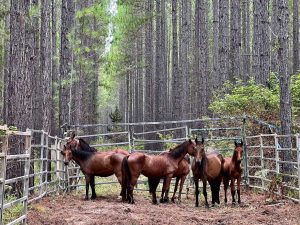Majestic But Unpredictable
Hopefully you have noticed the orange flashing warning signs on Tin Can Bay Road on the approaches to the Coondoo Creek area. These are in place to alert residents and visitors of the risk of horses crossing the road, as HQPlantations continues to take the lead to address the safety risk to road users from feral horse movement in close proximity to major public thoroughfares.
An exclusion fence can be seen on the eastern side of the Maryborough Cooloola Road in an attempt to limit horse movement and road crossings in this area. Research indicates that a feral horse population of between 2,000 and 3,000 horses is present in Tuan, Toolara, and adjacent state forests.
Another method of mitigation is to remove feral horse families along the roadside buffer zone using a passive trapping method. The process involves using dormant electric fencing on the ground to familiarise the horses to the fence before raising it in a very large area and making it live. After the horses are within the enclosed area the electric fence is slowly reduced until they are in a small area then yarded.
In February six feral horses were captured near Coondoo Creek using this method and have been relocated for rehoming. These horses were crossing the road on a regular basis and were a real risk to road users – and the road users were a risk to the horses!
While the sight of wild horses grazing along the roadside can appear majestic, they are unpredictable. HQPlantations urge drivers to navigate the Tin Can Bay and Maryborough Cooloola roads with caution, especially at night as they are often can’t be seen until it’s almost too late.







